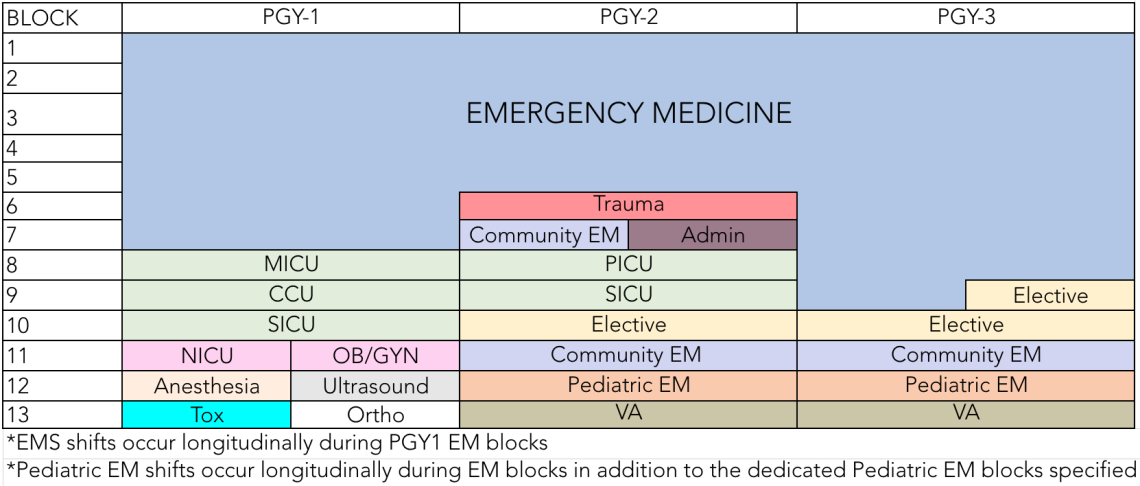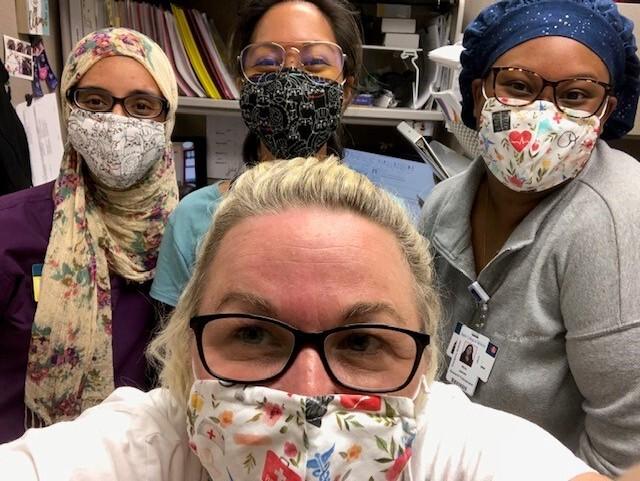Clinical Curriculum
The curriculum is designed to provide new clinical and intellectual challenges with each successive year, in a sequence of graded responsibility which guarantees mastery of emergency medicine upon graduation.

*EMS shifts occur longitudinally during EM blocks
*Peds EM shifts occur longitudinally during EM blocks, with dedicated Peds EM rotations as specified
PGY-1: Foundations of Practice
Over the course of intern year, our educational emphasis begins with functioning capably in the ED, and evolves incrementally to developing cognitive heuristics for common ED complaints, achievement of procedural competence, and finally proficiency with multitasking and managing a high patient census.
PGY-2: Critical Care Expertise
The focus of the second year is on applying knowledge and broadening procedural skill to comfortably and expertly manage the highest acuity patients as their primary provider, while simultaneously functioning as a resource for interns as they begin to see more complex cases.
PGY-3: Clinical Leadership
During their final year, our PGY-3s supervise junior and rotating residents, with the expectation that they see every patient in their clinical area, and are attentive to wait times and throughput. A predetermined percentage of shifts are also spent working directly with an attending so as to refine their individual clinical decision making and efficiency in preparation for independent practice.
Research and Mentorship

Emergency medicine is fast-paced and rapidly-developing, and so is research in our department. The faculty at Baylor studies the entire spectrum of patient population that you may encounter - prehospital studies to international medicine research in Belize, biomarker (TBI, cardiac, renal) testing to understanding health care disparities in underserved population, and investigating devices (radar technology) to understanding resident stress and education. Publishing more than once per week, routinely in the most prestigious journals in the house of medicine our departmental impact factor exceeds that of almost all emergency medicine residency programs in the United States.
Mentorship at Baylor means working with the best. Your attending might be the person with the largest ER hyperkalemia registry ever assembled, or has data on more than 200,000 hospitalized heart failure patients or working on novel traumatic brain injury biomarkers. It also means access to the Texas Medical Center Innovations program. This medical think tank/incubator successfully launches multiple companies every year that may redefine medicine and acute care in the United States. So for our staff, “cutting edge” is in the rearview mirror. If you want to see the future of emergency medicine, we are in the midst of it.
No where will you find better academic support. Our full-time research staff can help submit your protocol to the IRB, manage regulatory relations and handle budget negotiations. Our staff also enrolls and collects data 24/7. With our faculty to guide you through the process, your job is to think big and become famous.
Evidence Based Medicine
Life-long learning skills are essential for practicing physicians. Therefore, understanding the basic principles of EBM and appraising the literature is a core competency to be learned during residency. Journal club is the primary vehicle the program uses to teach residents the skills to maintain proficiency in the ever-evolving field of medicine. Specifically, JC is resident-driven, helps to assess milestones, and helps to achieve the core goal in developing skills as a life-long learner.
The goals for journal club include the ability to:
- Form a clinical question in PICO format
- Find literature to answer the question
- Appraise the literature
- Apply the findings to clinical practice, as applicable
Interns cover core topics in Epidemiology & Biostatistics during a review of landmark articles curated by the EBM faculty in advance of the academic year.
Senior residents search for their own papers based on a single clinical question and focus their discussion on a critical appraisal of the article, and how their findings might change their practice.








